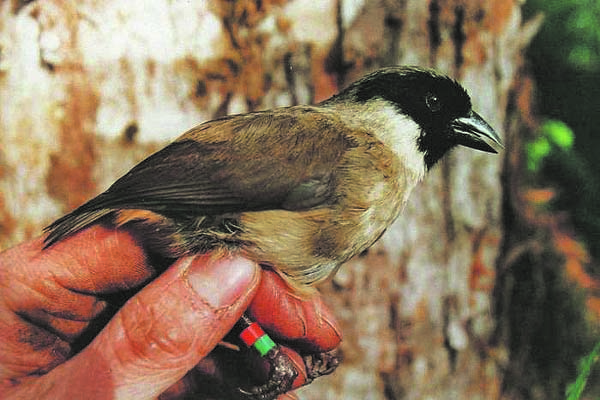Poouli, also known as black-faced honeycreepers, were once thought to exist in the hundreds on Maui. DLNR Division of Forestry and Wildlife photo
Eight species of Hawaiian honeycreepers, including one that may have once numbered in the hundreds in East Maui, have now been declared extinct.
The U.S. Fish and Wildlife Service on Monday finalized a rule removing 21 species of animals and plants across 17 states and territories from the list of threatened and endangered species and classifying them as extinct. They join the list of 650 U.S. species that have likely been lost to extinction, according to the Center for Biological Diversity.
“My heart breaks over the loss of these 21 species,” Noah Greenwald, endangered species director at the Center for Biological Diversity, said in a news release Monday. “These plants and animals can never be brought back. We absolutely must do everything we can to avert the loss of even more threads in our web of life.”
The eight bird species in Hawaii declared extinct are the Maui akepa, Maui nukupuu, kakawahie, poouli, Kauai akialoa, Kauai nukupuu, Kauai oo and kamao.
One species, the Maui nukupuu, hasn’t been seen since 1896, according to the center. The small bird was once found in high-elevation mesic and wet forests of ohia lehua and koa trees, whose bark it used to peck for insects.
Another, the kakawahie, also known as the Molokai creeper, was last sighed in montane west forest at Ohialele Plateau on the island in 1963. The bird’s bright red or orange feathers, said to resemble flames, were traditionally used for the capes and lei of alii.
For some, the last evidence of their existence was a distinct call. The Maui akepa, a small, dusty-green songbird whose call was a quivering whistle with a long trill, was last seen in 1988 and heard in 1995.
The species that was around most recently was the poouli. Also known as the black-faced honeycreeper, the birds were once thought to exist in the hundreds on Maui, according to the center. Inhabiting only the very wet, easternmost side of the island, they rapidly decreased in numbers because of habitat loss, mosquito-borne diseases, invasive predators and a decline in the native tree snails that the birds fed on. With the birds facing extinction, they were captured to breed in captivity, where the last three died in 2004. The center said the poouli might be alive today if conservation efforts had received proper funding.
One Hawaiian plant species proposed for delisting — Phyllostegia glabra var. lanaiensis, a flowering plant in the mint family that is endemic to Hawaii — retained its protections because of new surveys identifying new, potentially suitable habitats for the species, the Fish and Wildlife Service said in a news release Monday.
